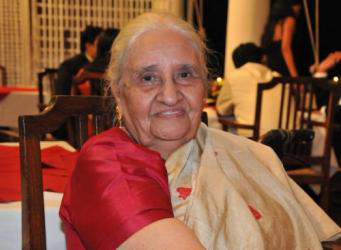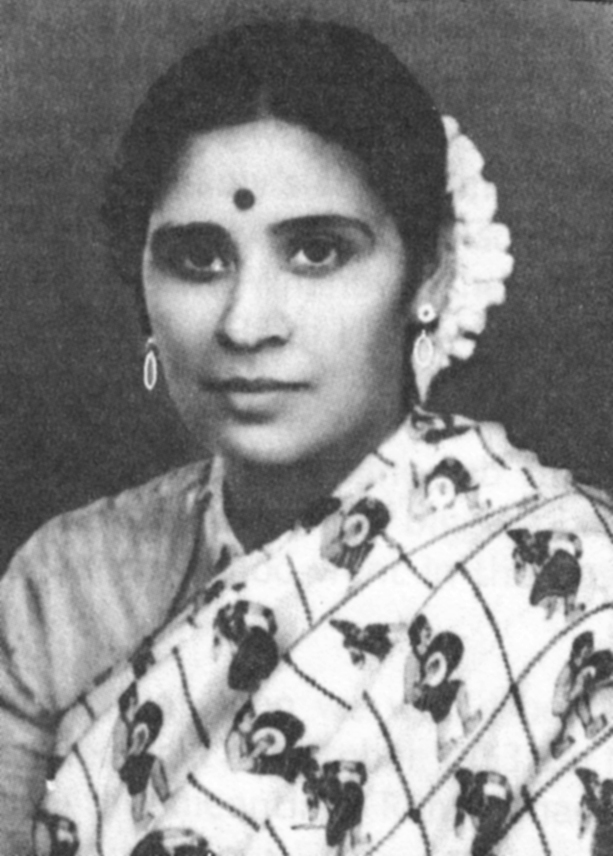
Visharda Hoon in retirement
Just being nostalgic is one thing. Reminiscing about your life and weaving events taken from diary jottings and publishing a book is quite another. Visharda Hoon’s Lahore to Chennai, a journey called life is in the latter bracket. N. Vaideeswaran, a colleague of the author, infers in his foreword that anybody who is somebody, and not necessarily the high and mighty, can write their biographies. This sets the tone for this hardbound book which includes black & white and colour pictures. A recent picture of the author in the front inside jacket sleeve of the book reveals a woman who doesn’t show her 87 years.
Written by hand beginning in 2010, the author portrays herself as a revolutionary student in pre-partition Lahore, wife and mother, teacher-administrator in Madras between 1954 and 1986, a social worker and a philosopher. Mrs. Hoon’s life in Madras runs concurrently with the Punjabi community putting down roots in the city. “Almost 63 years have passed since I left Model Town, Lahore, in 1947…” begins Mrs. Hoon, a semi-retired Chennai Gill Nagar resident today, and ends her story of 430 pages saying, “…As I sit in the veranda and listen to the bhajans that my grandson Aditya has loaded into my i-pod for my 85th birthday, I think life has been good, I could not ask for more.”
Providing an outsider’s view about Madras, Mrs. Hoon writes, “We had heard many stories about Madras from my cousin, whose husband was an Air Force officer, and posted in Madras in the 1940s. She told us that the people of Madras were simple and walked barefoot, that their food and customs were strange. She said it was like going to ‘Kala Pani’ (exile in Andamans)… she described the sea and liked the openness of the place. I remembered what she used to tell us and was a little apprehensive. She said older women wore nine yard sarees and young girls half sarees.” To this city there came by train in 1953 Mrs. Hoon, her husband Ranjit, their three children Vinoo, Vineeta, and Varuna, and their major-domo Munshi. They settled into a bungalow on Bishop Waller’s Avenue, near Edward Elliot’s Road. The monthly rent for the single-storeyed dwelling with a large terrace, where the family slept during the summer, was Rs. 150. A local maid, Jeelani Begum, who spoke Urdu and Tamil, was the Punjabi family’s interpreter. To get into the know of things, the Hoons were regular spectators at the Carnatic music and Bharata Natyam concerts held on the open-air stage in Hotel Woodlands near their house.
Mrs. Hoon started her long career in education in the South at the Children’s Garden School as an observer. Being at the “right place at the right time,” Mrs. Hoon, after a Masters in Psychology, was selected as the founder principal of the Punjab Association’s Adarsh Vidyalaya inaugurated on July 11, 1954. The school was established in a house set in about seven or eight grounds in Peter’s Road, Royapettah. The school was a natural choice for Punjabi, Marwari, Gujarati and Hindi speaking children. In 1957, Mrs. Hoon took a year off to study for a Bachelor’s course in Teaching at Lady Willingdon College in Triplicane. Among the many incidents she recalls, there is one about how she and her friends, pretending to be reporters, walked past the watchman into the Travancore Sisters’ house. But their consciences pricked, and they blurted out the truth. The sportive Ragini and Padmini not only briefed the teacher trainees about their just-concluded tour abroad, but also served the girls coffee.
In 1965, the author’s love for Geography prompted her to get a P.G. Diploma in the subject from the Madras University. Till today, Mrs. Hoon’s old students remember her more as a Geography teacher than as a principal. With colleagues like Geography teachers M.P. Rajagopal of M.Ct.M. School and Dr. Irawathy of Queen Mary’s College, she helped to start the Association of Geography Teachers of India which conducted periodical conferences and workshops for teachers, drafted the subject syllabi and made the topic more interesting for students through visual presentations and conducted off field trips, talent tests and quizzes. Fittingly, as a Geography teacher, Mrs. Hoon narrates her experiences travelling all over India, then in the USA as a Fulbright scholar to study school administration, and globe-trotting to China, Japan, U.S.S.R., Europe, and the Scandinavian countries as a member of the Indo-Soviet Friendship Society and Indian Federation of University Women’s Association.

Visharda Hoon as Founder –
Principal of Adarsh Vidyalaya
The author joined the Kendra Vidyalaya Sanghatan in 1965 and, like history repeating itself, took over as Principal of the fledgling Adarsh Kendriya Vidyalaya. The Punjab Association had been instrumental in starting this school too. It was initially managed out of Adarsh Vidyalaya itself, then moved to Royapettah High Road and in July 1968 to Gill Nagar. Mrs. Hoon was fully involved in the construction of the new school buildings in a developing locality. After five years at K.V. Gill Nagar, she was transferred to the school in the Air Force Station, Tambaram, a commute of 30 km, by cycle rickshaw and EMU trains. Her next posting was as Principal of KV IIT which included a primary school in the C.L.R.I. Campus. This was followed by a three-year sojourn at the KV in Kathmandu. She then returned to KV A.F.S., Tambaram, and KV C.L.R.I. After two decades, she retired as Education Officer of the KV Sanghatan, South. Mrs. Hoon also served as an advisory board member for social sciences in NCERT, New Delhi, and Mother Teresa Women’s University and as an honorary correspondent of Adarsh Schools for ten years from 1986.
Her pen portrait of life in Lahore provides a wealth of detail about the pre-Independence British Raj, her ancestral home built in 12 canals (1.5 acres), growing up in a Manglik family, her school and college education, the 1946 summer meetings at the hill station of Murree in Rawalpindi District with Khan Abdul Gaffar Khan, who wrote God is Love in her autograph book, Pt. Nehru, who wrote her a thank you note from Srinagar for her cash donation, and Jai Prakash Narayan, listening to leaders like Subhas Chandra Bose and Maulana Azad at Bradlaw Hall, Lahore, seeing the movie Sikandar eight times, hearing of the announcement of Partition in June, descriptions of the communal outrage, ‘Kafilas’, the massive caravans of people on foot moving from either sides of the border, fleeing to Dehra Dun, celebrating Independence there, moving to G.B. Road, Delhi, and living as refugees albeit with the self-reliant pride of the Punjabis, her wedding in January 1948, the assassination of Mahatma Gandhi on the same day, less than a couple of hours later, and writing her Master’s exam while expecting her first child.
Here is a book that tells not only her story, but recounts the life and events that surrounded her over eight decades. Few educationists have had the record she has. But at the end of it all, she is best remembered for her contributions to the Punjabis settling in Madras and to Geography.
|

